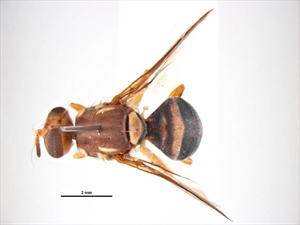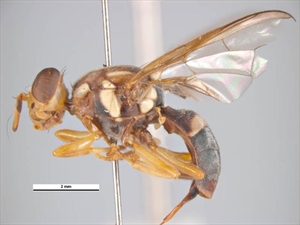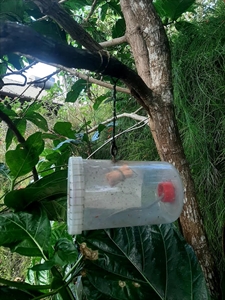Queensland fruit fly; abbreviation QFF.
Pacific Pests, Pathogens, Weeds & Pesticides - Online edition
Pacific Pests, Pathogens, Weeds & Pesticides
Queensland fruit fly (425)
Bactrocera tryoni
Oceania. It is recorded from Australia (eradicated in some states, and subject to eradication attempts in others), French Polynesia, New Caledonia, and Pitcairn.
Over 200 fruits and vegetables are hosts in 49 flowering families. Some of the main hosts are Annona species (soursop, custard apple, sugar apple), apple, avocado, capsicum, carambola, cashew, Citrus species, coffee, eggplant, guava, Indian almond (Terminalia catappa), Malay apple, mango, Pacific lychee (Pometia pinnata), papaya, passionfruit, peach, rose apple, sapodilla, sapote, Surinam cherry, Tahitian chestnut (Inocarpus fagifer) and tomato. Wild hosts are fish poison tree (Barringtonia asiatica), Java nut (Canarium vulgare), noni, and Phyllanthus (leafflower) species. Pineapples are not a host.
The QFF is a severe pest of a wide range of fruits and vegetables, capable of existing in diverse climates. It is potentially invasive as it infests fruit often carried by people while travelling.
Eggs are white, 1 mm long, banana-shaped, laid inside ripe fruits and vegetables just below the surface. The QFF can lay up to 100 eggs a day in small batches of 6 or so. Often, several females lay in the same fruit. The eggs hatch in 2-4 days and when mature the maggots are 7 mm long, carrot-shaped with an ability to curl into a 'U'-shape and jump. They chew their way out of the host and fall to the ground, burrowing into the soil to pupate.
Adults are 5-8 mm long (female longer than the male), brown marked with yellow, with transparent wings, 10-12 mm across (Photos 1&2). They use bacteria on leaf surfaces as a major source of protein (the basis of control measures using protein-bait sprays). There may be four to five overlapping generations a year. Activity increases after rains or during high humidity. Spread of QFF occurs on the wing, they are strong fliers, and as larvae in infested fruit.
Waterhouse1 states: "The Queensland fruit is the most destructive pest of fruit and vegetables in tropical, sub-tropical and temperate eastern Australia. It infests... all commercial crops except pineapple". Losses to fruit flies in Australia if not controlled is put at A$100 million a year, mostly due to QFF.
Look for the red-brown colour of the thorax from above, with its two yellow stripes towards the sides (Photo 1). Look for the small black spots on the face below the antennae. Male flies are attracted to Cue-lure (a sex pheromone) and both males and females to protein baits. Traps containing either of these ingredients are usually hung within shade tree canopies, one or two per ha (Photo 3). Because of the similarity of this fruit with others, e.g., melon fly, see Fact Sheet no. 505), it is important that specimens are examined by a taxonomist familiar witt the different species.
BIOSECURITY
Countries not yet infested by the QFF should consider all likely pathways for entry, and apply quarantine measures accordingly. Fruit and vegetables may need to be treated to manage risk of fruit fly introduction by, e.g., high-temperature forced-air, low temperature, insecticide dips, irradiation, area freedom, or area-wide management.
The invasiveness of the fruit is shown by introductions to New Caledonia (1969), French Polynesia (1970) that have not been eradicated, and introductions into Western Australia (1988), Easter Islands (1971) and Cook Islands (2005) that were eradicated. Recent outbreaks (2019) in New Zealand, as well as in fruit-fly free areas of South Australia, Victoria and New South Wales are under eradication.
NATURAL ENEMIES
Although parasitism can be up to 30% it is not thought to affect levels of damage. Fopius arisanus, Diachasmimorpha tryoni and Diachasmimorpha karaussii are the parasiotoids considered to have potential as biocontrol agents.
AREA FREEDOM FROM FRUIT FLY
Many countries have government schemes to check for fruit fly incursions and to comply with market access protocols. This is the basis of control in commercial areas, such as the Greater Sunraysia Pest Free Area in parts of Victoria and NSW, Australia. The aim is to prevent any fruit fly invading the area from completing its life cycle. It is supported by a number of cultural control measures.
Traps are placed at sea and airports and in fruit-fly free areas on a 1 km grid format (possibly less in urban areas, and around orchards), and checked weekly. Control programs are triggered based on the number and sex of flies caught per trap within a specified time interval. Public awareness, preventing uncontrolled fruit and vegetables entering the designated fruit-fly free areas, is central to the success of the strategy.
AREA-WIDE MANAGEMENT
AWM is used to reduce populations of fruit flies by monitoring, trapping with pheromone, protein bait sprays, male annihilation technique, cover sprays and the implementation of cultural practices within a local area by getting growers and the community to collaborate throughout the year. An example is the Yarra Valley QFF Action Plan, Victoria, Australia.
ERADICATION
This is usually attempted by (i) defining a 1.5 km quarantine area around the outbreak site, (ii) control of fruit movement, (iii) removal of fruit on infested trees and collecting fallen fruit, (iv) protein bait and insecticide sprays (to attract and kill male and female flies), (v) management of green waste, and vi) male annihilation technology (high density traps, 10-20 per ha, containing sex pheromone plus insecticide in compressed fibreboard or cardboard). Sterile insect technology (SIT) is frequently applied after protein bait sprays with the release of 100,000 sterile flies per km2 twice a week for up to 12 weeks.
CULTURAL CONTROL
The control measures that follow are especially for home gardens or smallholdings, although the same principals and methods are applicable to larger commercial enterprises.
During growth:
- Monitor:
- Trapping: Use a pheromone (Cue-lure) trap to attract male fruit flies to see if they are active in your garden or orchard. It's best to place the traps in trees as QFF likes shade, but also place them in trees at edges of the crop. Collaborate with neighbours to do the same. Traps contain a rapid-kill insecticide (malathion or dichlorvos, in Australia). Note, dichlorvos is banned in the European Union. A video on monitoring is here.
- Check fruit: Cut open mature fruit at regular intervals for presence of maggots; also, check for marks called 'stings' on the skin where females have laid their eggs.
- Protein baits:
- Use a protein bait (e.g., yeast autolysate from brewery waste) with an insecticide (e.g., malathion or spinosad in Australia) to control male and female fruit flies applied in spots or bands on trunks, branches or foliage, 5-8 weeks before harvest, depending on the fruit. The bait is best applied weekly as it is susceptible to weathering.
- Hygiene:
- Exclusion: Use nets or bags to protect fruit and vegetables (especially useful in home gardens). Install after fruit set, at least 6 weeks before harvest. Curtain mesh is ideal, and so are brown paper bags.
- Early harvest: Harvest mature green fruits.
- Clean up: Pick up and dispose of fallen and overripe fruit.
- Note, it is important to remove fruit and to collect those fallen from abandoned trees adjacent to an orchard where fruit flies are being controlled. If not possible, the trees should be sprayed with insecticide, or the fruit picked before maturity.
After harvest:
- Collect and destroy the remains of harvests, especially fruits left on trees, shrubs, vines, etc. by crushing the fruits with a boot, ploughing into the soil or by burning. Small numbers of fruit can be placed in plastic bags and left in the sun for a few hours to kill the maggots
- Do not compost or put infested fruit in garbage bins. The remaining plant debris can be used as a mulch or incorporated into soil.
RESISTANT VARIETIES
Grow fruits and vegetables that are non-hosts of Queensland fruit fly. However, only a few are listed by Agriculture Victoria: choka, coffee berries, date, dragon fruit. Pineapple is a non-host, mentioned above.
CHEMICAL CONTROL
Cover sprays over the entire crop have given way to protein bait sprays as they are more economical. Previously, dimethoate and fenthion were used widely. In Australia, fenthion is no longer permitted, but dimethoate is still registered. Conditions of dimethoate use against QFF depend on the crop and (in some crops the variety), how grown (field or protected cropping), the use of the crop (fresh consumption or processing), when and how applied (dip or spray) and concentration; therefore, see manufacturers' instructions for details. In general, dimethoate is used on fruits with inedible peel. Dimethoate is not allowed for home garden use in Australia. Use of dimethoate in the European Union will expire in July 2020.
____________________
When using a pesticide, always wear protective clothing and follow the instructions on the product label, such as dosage, timing of application, and pre-harvest interval. Recommendations will vary with the crop and system of cultivation. Expert advice on the most appropriate pesticide to use should always be sought from local agricultural authorities.
AUTHOR Grahame Jackson
Information (and Photos 1&2) Hinkley S, Walker K (2005) Queensland Fruit Fly (Bactrocera tryoni): PaDIL - (http://www.padil.gov.au); and Ekman J (2016) Fruit fly management for vegetable growers. Applied Horticulture Reseach. Horticulture Innovation Australia. (http://ahr.com.au/wp-content/uploads/2017/01/Fruit-Fly-guide-Booklet.pdf); and Information for gardeners. Agriculture Victoria. (http://agriculture.vic.gov.au/agriculture/pests-diseases-and-weeds/pest-insects-and-mites/queensland-fruit-fly/gardeners); and CABI (2018) Bactrocera tryoni (Queensland fruit fly). Crop Protection Compendium. (https://www.cabi.org/cpc/datasheet/17693); and from Waterhouse DF (1993)1 Biological Control Pacific Prospects - Supplement 2. ACIAR Monograph No. 20. Brown Prior Anderson, Burwood, Victoria;
Produced with support from the Australian Centre for International Agricultural Research under project HORT/2016/185: Responding to emerging pest and disease threats to horticulture in the Pacific islands, implemented by the University of Queensland and the Secretariat of the Pacific Community.






